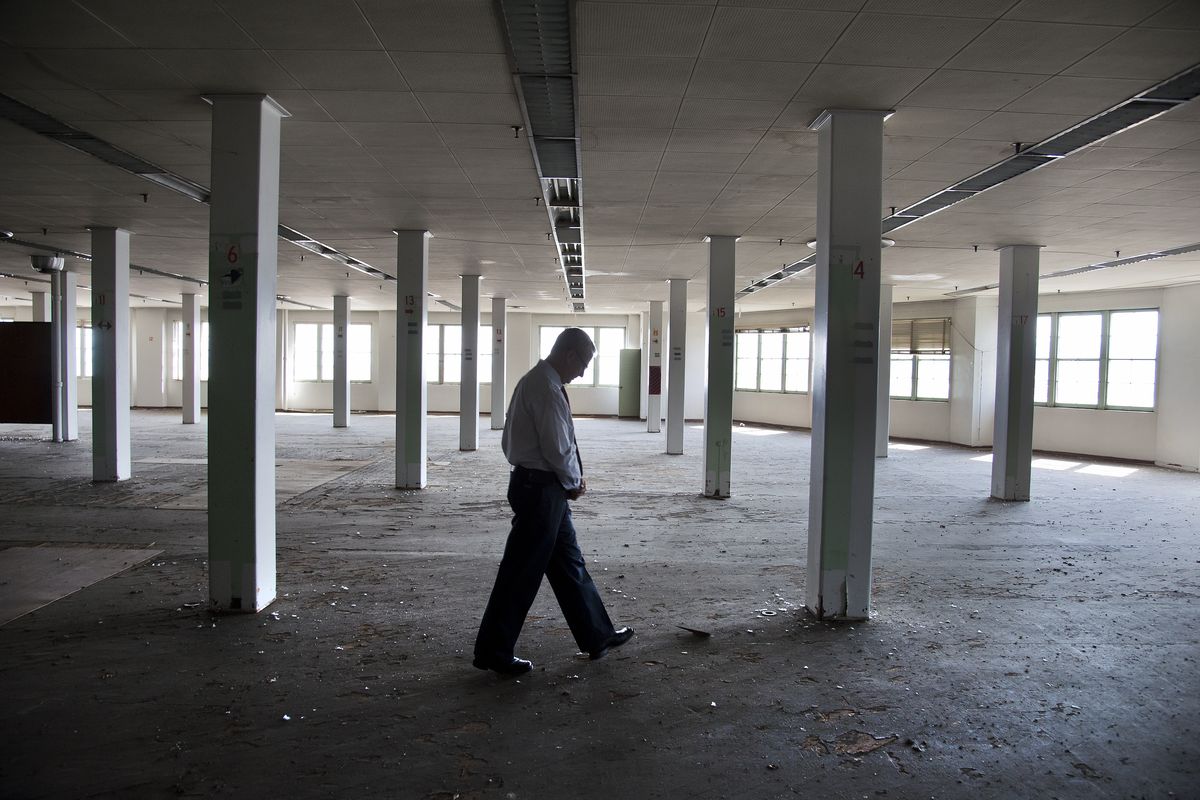Jensen-Byrd building’s fate teeters between restoration, demolition

A dead pigeon lies in a corner of the old hardware warehouse, all bones and feathers. The fir and maple floors are dirty, scuffed and occasionally routed. The fire sprinkler pipes are rusty, vulnerable to failure.
But the structure of the brick, six-story former Jensen-Byrd warehouse, just east of downtown Spokane, is sound. Its beams, a horizontal forest of fir, are thick. Although cracked at the edges, its roof keeps the rain out.
In the past few years, the future of the Jensen-Byrd warehouse, owned by Washington State University, has become the central debate over historic preservation in Spokane. Where some see a drab abandoned warehouse, others see a grand opportunity: a potential campus landmark that could house enterprise while showcasing the past.
The university, which bought the building in 2001, has given mixed signals. In the past decade, WSU officials have both talked about their desire to preserve it and argued for the right to tear it down.
The closest WSU came to developing the property was a demolition project; Texas-based Campus Advantage agreed to buy the Jensen-Byrd warehouse in 2011 and announced plans to tear it down. The company wanted to replace it with new apartments and retail space. But facing a challenge from Spokane Preservation Advocates, a nonprofit that works to preserve the city’s historic character, the company pulled out of the deal a year ago.
The potential of saving the building has brightened considerably since then. Lisa Brown, chancellor of WSU Spokane, said the university has been approached by about a half-dozen developers interested in rehabilitating it.
While officials won’t say that the university is committed to saving the building, they have started to embrace the idea of it remaining on the Riverpoint campus, home to WSU Spokane.
“We’re getting enough interest to make us think that is likely to occur,” Brown said.
What’s changed, Brown said, is that more of the university’s potential has been realized. The $80 million Pharmaceutical and Biomedical Sciences Building will open later this year and will house WSU’s College of Pharmacy. With the economy improving, more businesses and institutions want to be close to campus.
Bought by Jensen-Byrd in 1958
The Jensen-Byrd warehouse was built in 1909 by the now-defunct Marshall-Wells Hardware Co. of Duluth, Minn. At the time, the company was expanding quickly and building several hardware warehouses across the country. It would soon be known as the largest hardware wholesaler in the world.
“We’re pretty proud of it,” said David Marshall, the grandson of Seth Marshall, who led the construction of the Spokane warehouse. “It’s been gone for decades, but it’s still in our blood.”
Marshall moved to Spokane with his family in the mid-1950s when his father was placed in charge of Spokane operations. A couple years later, however, Marshall-Wells folded, and its Spokane warehouse was sold in 1958 to Jensen-Byrd, a local hardware company with its own storied history.
Marshall, who lives in Portland, said he doesn’t have “emotional ties” to the Spokane warehouse, but questions the desire to tear it down given the success of redeveloping the former Marshall-Wells warehouse in Portland.
That warehouse, in the celebrated, revitalized Pearl District, was converted into residential condos a decade ago.
The website for the Marshall-Wells residential lofts sounds more Portland – maybe even “Portlandia” – than Spokane: “Loft living presents a unique opportunity to shed convention, simplify our lives, and say ‘yes’ to a new way of living. The Marshall-Wells Lofts present the classic, authentic, minimalist’s approach to living. Pure and simple.”
But to developers hoping to save the Jensen-Byrd, the Portland building serves as a reminder that Spokane’s warehouse can also have new life.
Ron Wells, a developer who specializes in historic buildings, has submitted two previous proposals for the warehouse. He said he’s working on a new concept with other investors and can’t discuss many specifics. But he added he’s no longer focused on housing and is working on a plan that would meld with the university’s health focus.
“It’s really an iconic building for Spokane’s east end and the University District,” Wells said. He declined to say how much it would cost to rehabilitate but said a deal would make financial sense, especially with historic tax credits.
“Maybe the third time will be a charm,” Wells said.
Demolition plans sparked outcry
The proposed demolition of the warehouse sparked the most passionate opposition by historic preservationists since the Rookery Block of buildings was demolished in the downtown core in 2006. The Spokane City Council even considered a resolution to persuade the university to back off demolition plans. It failed on a 4-3 vote.
“Just because a building is old doesn’t mean it’s usable or savable,” Councilman Mike Allen said during the debate.
But Matt Cohen, past president of Spokane Preservation Advocates, said rehabilitation projects like Jensen-Byrd “record the vibrant early-20th-century history of Spokane as a regional railroad hub and commercial center” as well as give character to neighborhoods and make them more pedestrian-friendly.
“All of those benefits translate into unique economic value for Spokane,” he said. “Those benefits make Spokane a place where people want to live and do business, and where they have the opportunities to do so.”
Brown said the university will update its master plan this year and ask for proposals for the Jensen-Byrd warehouse in the spring.
“We are committed to going through a process that gives us a sense of what can be a great use for that building as part of a health sciences education and research campus,” she said.
She toured the Jensen-Byrd for the first time this month. She especially was impressed by the view from the roof: downtown, industry, hospitals and the rest of the campus.
“I think it is a really interesting building with a lot of potential,” Brown said. She added, however, “I thought the basement was scary.”